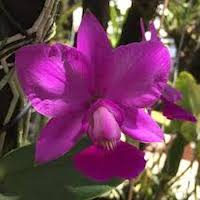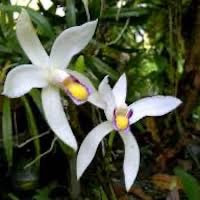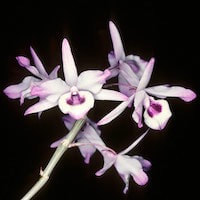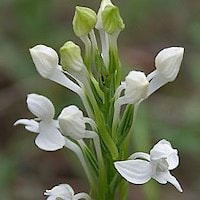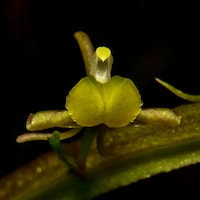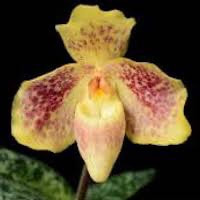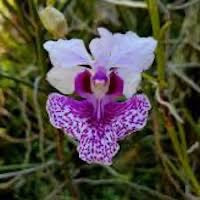Experience the Essence of Oriental 12 Women Fragrance Oil
Scentopia's perfume boasts a wide array of scented notes, including several native Singaporean Orchid varieties with their own distinctive traits. One such note is Cattleya Aloha Case (Dark Purple Form), renowned for its deep red-purple, large, and extremely fragrant flowers that stand out in comparison to the plant's size. This orchid, prominently featured in the Oriental 12 (Women) Team Building Perfume workshop, offers a captivating aroma.
In the Therapeutic Orchid notes, Bromheadia finlaysoniana from Malaysia exhibits a unique flowering pattern. On certain days, its flowers are abundant, while on others, they are scarce. The decoction of its roots is traditionally used for rheumatism in Malacca, while in Peninsular Malaysia, chewing its flower stalks is believed to alleviate asthma. Dendrobium transparens Wall ex Lindl., found across the eastern Himalaya to Yunnan and Myanmar, is used to treat fractures and dislocated bones in Nepal. Habenaria Willd., known as Phoenix/Heron Flower, requires distinct wet and dry seasons for proper flowering, and its underground tuber endures the dormant phase until the next rainy season. Liparis rheedii Lindl., distributed across India to Southeast Asia, exhibits color variations based on light exposure and is widely used as a tonic in Karnataka, and its root is employed to treat cholera.
Paphiopediulun concolor (Lindl. ex Bateman) Pfitzer is used in Chinese Traditional Medicine to relieve coughs and asthma, alleviate pain, and treat conditions like tuberculosis and rheumatoid arthritis, often in combination with other herbs. Papilionanthe hookeriana (Rchb.f.) Schltr. Syn Vanda hookeriana is native to mangrove swamps in the Kinta Valley of Peninsular Malaysia and is also found in Sumatra, Borneo, and Indochina. Its hot paste is used for treating painful joints in northern Peninsular Malaysia.
In addition to the orchid notes, the perfume also incorporates scent notes of coffee, woody orchid bark, tonka bean, amber, and spice, adding complexity and allure to the fragrance. Furthermore, Scentopia's scent library features "Tobacco of the green kind" as a reference ingredient for an intriguing olfactory experience.
With the combination of these native Singaporean Orchid notes and other aromatic elements, the perfume at Scentopia offers a captivating and alluring fragrance, sure to delight the senses and leave a lasting impression.
In the Therapeutic Orchid notes, Bromheadia finlaysoniana from Malaysia exhibits a unique flowering pattern. On certain days, its flowers are abundant, while on others, they are scarce. The decoction of its roots is traditionally used for rheumatism in Malacca, while in Peninsular Malaysia, chewing its flower stalks is believed to alleviate asthma. Dendrobium transparens Wall ex Lindl., found across the eastern Himalaya to Yunnan and Myanmar, is used to treat fractures and dislocated bones in Nepal. Habenaria Willd., known as Phoenix/Heron Flower, requires distinct wet and dry seasons for proper flowering, and its underground tuber endures the dormant phase until the next rainy season. Liparis rheedii Lindl., distributed across India to Southeast Asia, exhibits color variations based on light exposure and is widely used as a tonic in Karnataka, and its root is employed to treat cholera.
Paphiopediulun concolor (Lindl. ex Bateman) Pfitzer is used in Chinese Traditional Medicine to relieve coughs and asthma, alleviate pain, and treat conditions like tuberculosis and rheumatoid arthritis, often in combination with other herbs. Papilionanthe hookeriana (Rchb.f.) Schltr. Syn Vanda hookeriana is native to mangrove swamps in the Kinta Valley of Peninsular Malaysia and is also found in Sumatra, Borneo, and Indochina. Its hot paste is used for treating painful joints in northern Peninsular Malaysia.
In addition to the orchid notes, the perfume also incorporates scent notes of coffee, woody orchid bark, tonka bean, amber, and spice, adding complexity and allure to the fragrance. Furthermore, Scentopia's scent library features "Tobacco of the green kind" as a reference ingredient for an intriguing olfactory experience.
With the combination of these native Singaporean Orchid notes and other aromatic elements, the perfume at Scentopia offers a captivating and alluring fragrance, sure to delight the senses and leave a lasting impression.
Other fragrance oils- Oriental 1, Oriental 2, Oriental 3, Oriental 4, Oriental 5, Oriental 6, Oriental 7, Oriental 8, Oriental 9, Oriental 10, Oriental 11, Oriental 12
Download the guided mediation that works best with this Orchid fragrance oil
| women_oriental_essential_oil_orchi_00012.mp3 | |
| File Size: | 42798 kb |
| File Type: | mp3 |
Therapeutic Benefits Customized for Women
Contains Scented Notes of following in various proportions:
Native Singaporean Orchid notes: Cattleya Aloha Case (Dark Purple Form)
|
Cattleya Aloha Case (Dark Purple Form) - Used in Oriental 12 (Women) for Team building Perfume workshop
Cattleya Aloha Case (Dark Purple Form) is a captivating orchid variety chosen for inclusion in Oriental 12 (Women) team-building perfume workshop. This orchid stands out with its striking deep red-purple flowers, exuding a rich and alluring hue. The flowers of Cattleya Aloha Case are noteworthy for their size, appearing large in comparison to the overall size of the plant. Their impressive dimensions add to the visual allure of this orchid, making it a captivating centerpiece. Beyond its visual appeal, Cattleya Aloha Case boasts an exceptional fragrance, adding a delightful sensory experience to the perfume workshop. The large and fragrant flowers provide ample aromatic inspiration for the participants to explore and blend scents, fostering creativity and collaboration. By incorporating Cattleya Aloha Case in the team-building experience, Oriental 12 (Women) creates an atmosphere of beauty, inspiration, and shared creativity. Participants will have the chance to immerse themselves in the captivating scents of this orchid while engaging in collaborative activities, further enhancing the overall experience and making it a memorable and enjoyable event for all involved. |
Therapeutic Orchid notes:
|
Bromheadia finlaysoniana
Malaysian names: Seraman in Kelabit, Wi buntak (Iban), Busak paya (Malay) There are 17 species distributed from Sri Lanka across Southeast Asia to Australia. Two Malaysian species, B. brevifolia and B. ruprestris, occur in the highlands. finlaysoniana is a Malaysian lowland species. Bromheadia finlaysoniana is an orchid species found in Malaysia, with various local names such as Seraman in Kelabit, Wi buntak in Iban, and Busak paya in Malay. It is part of a larger group of 17 species distributed from Sri Lanka across Southeast Asia to Australia. While two Malaysian species, B. brevifolia and B. ruprestris, are found in the highlands, B. finlaysoniana thrives in the lowlands of Malaysia. The flowering behavior of B. finlaysoniana is intriguing. Some days, the flowers are abundant, while on other days, no flowers are seen. This is due to the unique growth pattern of the flower buds. When the flower buds reach a length of 12 mm, their growth abruptly slows down, allowing younger buds to catch up. On an unusually cool day, their development accelerates, and seven days later, the orchid blooms in a gregarious manner, showcasing its charming flowers. In traditional Malaysian herbal practices, B. finlaysoniana has been used for its medicinal properties. In Malacca, a decoction of the roots was consumed to address rheumatism, highlighting the orchid's potential as a natural remedy for this condition. In Peninsular Malaysia, the flower stalks were chewed for treating asthma, indicating its use in managing respiratory issues. In Sarawak, the orchid was utilized to alleviate body aches, showcasing its versatile applications in traditional medicine. The traditional use of Bromheadia finlaysoniana in Malaysia reflects the deep connection between local communities and their natural environment. Orchids like B. finlaysoniana hold cultural and medicinal significance, contributing to the well-being and traditional knowledge of the people in the regions where they are valued. Preserving and respecting these traditional practices ensures the continuation of ancient healing traditions and sustains the cultural heritage of these botanical treasures for future generations. |
|
Dendrobium transparens Wall ex Lindl.
Nepali name: Parajivi, Thuur Dendrobium transparens Wall ex Lindl., known by its Nepali names Parajivi and Thuur, is an orchid species distributed from the eastern Himalaya to regions like Yunnan and Myanmar. In traditional herbal practices in Nepal, Dendrobium transparens is utilized for its therapeutic properties in treating fractures and dislocated bones. This orchid species holds significance in traditional medicine, where it is believed to aid in bone healing and provide relief to individuals with bone-related injuries. It is interesting to note that Dendrobium catenatum was considered the most important and commonest species in Traditional Chinese Medicine (TCM). However, other unconventional species like Dendrobium transparens are also recognized for their potential medicinal applications. The traditional use of Dendrobium transparens in Nepal and the recognition of unconventional Dendrobium species in TCM highlight the rich knowledge of botanical resources and their diverse applications in traditional healing practices. Orchids like Dendrobium transparens play an important role in cultural heritage and natural remedies, supporting the health and well-being of communities in the regions where they are esteemed. Preserving and respecting these traditional herbal practices ensures the continuation of ancient healing traditions and sustains the cultural heritage of these botanical treasures for future generations. |
|
Habenaria Willd.
Chinese name: Yufeng hua (phoenix/heron flower) Japanese name: Mizu Tombo Sanskrit name: Riddhi Habenaria Willd. is an intriguing genus of orchids with cultural significance across different regions. In Chinese, it is known as Yufeng hua, which translates to phoenix/heron flower, while in Japanese, it goes by the name Mizu Tombo. Additionally, in Sanskrit, it is referred to as Riddhi. Habenaria orchids have a unique life cycle, thriving in areas with distinct wet and dry seasons. They require a dormant phase to flower properly, and even to survive. When the first rain arrives, the plant sends out an aerial shoot, which rapidly grows during the two months of heaviest rainfall, eventually producing flowers. After the rainy season ends, the aerial portion of the plant dies down, leaving the underground tuber to await the next rainy season. This adaptation enables the orchid to endure and thrive in specific climatic conditions. The generic name "Habenaria" has its roots in Latin, derived from "habena," which translates to bridle, whip, strap, or veins. This description reflects the thread-like fringe found on the lip of some Habenaria species, adding to the beauty and intrigue of these orchids. The cultural names and botanical characteristics of Habenaria highlight the fascination and appreciation people have for these orchids. Their life cycle and unique adaptations have captured the attention of botanists and enthusiasts alike, making them a cherished part of the natural world and a symbol of resilience and beauty. Whether admired for their striking flowers or studied for their ecological significance, Habenaria orchids continue to inspire wonder and admiration in various cultures and scientific communities. |
|
Liparis rheedii Lindl.
Indian Name: Simil Liparis rheedii Lindl., commonly known as Simil in India, is a fascinating terrestrial herb characterized by closely spaced pseudobulbs. The appearance of both the plant and its flowers is influenced by the amount of light it receives. Plants growing in the shade display a deep purple color, while those exposed to more light appear as pure green. This intriguing color variation adds to the charm of Liparis rheedii. The distribution of Liparis rheedii spans from southern India, across Thailand, Indochina, Malaysia, and Indonesia to New Guinea, showcasing its adaptability to diverse mountain forests. In traditional herbal practices in Karnataka, Liparis rheedii is widely used as a tonic, reflecting its medicinal value as a health-promoting remedy. Notably, it is one of the eight ingredients of the Ayurvedic drug known as Ashtavarga, indicating its significance in traditional Ayurvedic medicine. The root of Liparis rheedii is utilized by hill tribes in Orissa to treat cholera. To prepare the remedy, about 250 grams of the root is decocted in a liter of water until the volume is reduced to 333 ml. After cooling, 5 ml of the decoction is mixed with 2 ml of honey and orally administered twice a day on an empty stomach for 15–21 days. The traditional use of Liparis rheedii as a tonic and as a remedy for cholera reflects the profound knowledge of botanical resources and their therapeutic potential in traditional healing practices. Orchids like Liparis rheedii continue to play an important role in cultural heritage and traditional remedies, supporting the health and well-being of communities in the regions where they are valued. Preserving and respecting these traditional herbal practices ensures the continuation of ancient healing traditions and sustains the cultural heritage of these botanical treasures for future generations. |
|
Paphiopediulun concolor (Lindl. ex Bateman) Pfitzer
Chinese name: Tongseduo Lan (uniform colour pouch orchid) Chinese medicinal name: Bazhangcao, Shizilixian Paphiopedilum concolor (Lindl. ex Bateman) Pfitzer, known as Tongseduo Lan (uniform color pouch orchid) in Chinese, also holds Chinese medicinal names Bazhangcao and Shizilixian. This orchid species is distributed in regions such as Guangxi, Guizhou, Yunnan, Indochina, Thailand, and Myanmar, particularly thriving on limestone. In Traditional Chinese Medicine (TCM), Paphiopedilum concolor is classified as having a "hot and neutral" nature. The entire plant is used for various medicinal purposes, including relieving coughs and asthma, clearing gas, and providing pain relief. It is employed in treating conditions such as pulmonary tuberculosis, bone and joint pains, rheumatoid arthritis, and chronic gastroenteritis. The herb is not used in isolation but is often combined with other complementary herbs for enhanced efficacy. In specific herbal preparations, the fresh plant of Paphiopedilum concolor is pounded and utilized for different therapeutic purposes. For soft tissue trauma, alcohol is added to the mashed plant. For treating sores, red sugar is included. In cases of snake bites, 30-60 grams of pulverized whole plant is mixed with 30-60 milliliters of white wine. The juice is consumed, and the residue is applied to the bitten area. The traditional use of Paphiopedilum concolor in TCM reflects the rich knowledge of botanical resources and their therapeutic potential in addressing various health issues. Orchids like Paphiopedilum concolor play an essential role in traditional medicine, contributing to the well-being and healing practices of communities in the regions where they are esteemed. Preserving and respecting these traditional herbal practices ensures the continuation of ancient healing traditions and sustains the cultural heritage of these botanical treasures for future generations. |
|
Papilionanthe hookeriana (Rchb.f.) Schltr. Syn Vanda hookeriana
Malaysian names: Kinta weed, pokok tulang (bone plant) Indonesian names: Anggerik pensil (pencil orchid), Potloodorchidee (in Dutch) Papilionanthe hookeriana (Rchb.f.) Schltr., also known as Vanda hookeriana, is an orchid species with various names in different regions. In Malaysia, it is referred to as Kinta weed and pokok tulang (bone plant), while in Indonesia, it is known as Anggerik pensil (pencil orchid) and Potloodorchidee in Dutch. This native plant thrives in the mangrove swamps of Kinta Valley in Peninsular Malaysia and is also found in other regions such as swampy, open, sunny areas with high rainfall amidst thickets and shrubs in peninsular Thailand and Malaysia, Sumatra, Borneo, and Indochina. In traditional herbal usage in northern Peninsular Malaysia, a hot paste derived from Papilionanthe hookeriana is used for treating painful joints. The medicinal application of this orchid highlights its potential in providing relief and support for individuals dealing with joint-related discomfort. The traditional use of Papilionanthe hookeriana in Malaysia reflects the deep connection between local communities and their natural environment. Orchids like Papilionanthe hookeriana hold cultural and medicinal significance, contributing to the well-being and traditional knowledge of the people in the regions where they are valued. Preserving and respecting these traditional practices ensures the continuation of ancient healing traditions and sustains the cultural heritage of these botanical treasures for future generations. |
Other scent note
Scentopia Library Reference ingredient
Tobacco of the green kind - Check details at Scentopia's scent library
Join Scentopia's wonderful orchid scent crafting, fragrance tour, bridal shower or corporate team building which includes perfume making onsite and offsite, beach activities and more. We also serve primary school learning journey, secondary students and pupil on industrial excursions. Know more about our orchids perfume bar or therapeutic orchid scents and other wellness aromas. Conatct Perfume workshop or book a scent crafting session here.
